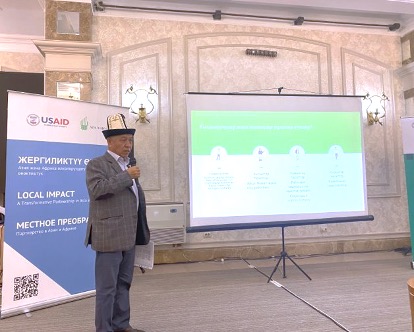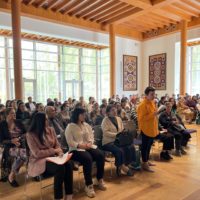
Abdizhapar from Uzgen, Osh making the final pitch on agro-forestry initiative to win $10,000 to pilot his initiative
Climate change is a major challenge facing our world today. While some progress has been made, new solutions are urgently needed to stabilize climate risks more rapidly and sustainably, for a safer future for us all.
In order to adapt agriculture to climate change, we need to design systemic solutions that are environmentally friendly, agriculturally productive, and financially sustainable. This is only possible with local leadership, ingenuity, and collaboration.
Local Innovations
Imagine a cluster of water reservoirs in valleys that promotes water conservation, provide irrigation facilities to small holder farmers, while enabling reforestation of neighboring land and income generation by growing mountainous herbs and berries. Or how low-grade sheep wool can be repurposed as biofertilizer and soil moisturizer, thereby reducing dependence on mineral fertilizers. Imagine how drone technology can be used for precision distribution of bio-fertilizers and pest surveillance while reducing waste and increasing agriculture efficiency.
As Heads of State, leaders of organizations, climate activists and civil society representatives met at COP27 to deliver action on an array of issues critical to tackling the climate emergency, the Local Impact team was moving a community-led approach to increase agricultural adaptation and climate resilience forward in the Kyrgyz Republic.
A landlocked mountainous country in Central Asia, the Kyrgyz Republic is the third most vulnerable country to the impact of climate change in Eastern Europe and Central Asia, primarily due to the sensitivity of its agricultural systems. During the last 20 years, the average temperature in Kyrgyz Republic has increased from 4.8°C to 6°C. According to the most pessimistic estimates, the average temperature in Kyrgyz Republic could increase by 8°C during this century, significantly above the global average.
Agriculture is the mainstay of the Kyrgyz economy, employing about 40 percent of the country’s labor force and accounting for 20 percent of the gross domestic product.
For some communities, the biggest challenge is water scarcity and broken irrigation systems. For others, land degradation due to drought, unpredictable seasonal weather, and increased use of inorganic fertilizers might be the biggest one.
Regardless of the specific problems facing a community, the impact of climate change causes loss of life and livelihoods, increases food insecurity, amplifies vulnerability, and compounds poverty across the country.
To respond to these challenges, AKF is shifting the power toward communities and approaching co-creation by inviting communities to design, manage and implement their projects. AKF is working to facilitate the process, but the mitigative solutions are locally owned and operated.
To increase agricultural adaptation and climate resilience, small holder farmers, community-based organizations, and academicians came together to design contextual and innovative solutions to the problem of irrigation and natural water resource management, agricultural waste management and recycling, soil ecosystems and fertilizers efficiency.
AKF is taking global best practices and learnings and applying them locally building on what is also known as community-led design or diffuse design approach.
Through these approaches and methodologies, AKF is able to:
- Harness the traditional knowledge of communities to develop innovative solutions
- Increase community engagement and ownership of solutions
- Contextualize and share our HCD toolkit and methodology
- Strengthen problem solving capacity and collaboration in these communities
The community-led design process in Kyrgyz Republic focused on four key areas:
- Social Mobilization – The activation of local communities started with open invitation to share ideas and solutions with the aim of inspiring communities to see themselves as change agents and encourage organizations to see communities as partners rather than beneficiaries in development.
- Empowering Local Champions of Change – Through an inclusive workshop focused on HCD tools and methodologies community members were tasked with conceptualizing a clear solution to a locally-identified problem. Teams were coached through a rapid design process applied to their project ideas, closely facilitated by design experts, and supported with relevant and inspiring case studies. Finally, teams were invited to pitch their ideas and six shortlisted projects were given a seed fund of $10,000 to pilot their initiatives based on a set of criterions determined by local experts.
- Piloting with Support – We will support shortlisted teams to pilot their solution by establishing a standardized process for planning and implementation, contextual and relevant goal setting to achieve measurable outcomes, solid gender action plan to include women while implementing the solutions, and a communication strategy for effective engagement and outreach.
- Long-term Sustainability – We will support pilot projects towards financial sustainability, self-governance, and scalability by facilitating linkages with experts, organizations, and local governments to support their project activities.
As a result of this work, a pipeline of climate-smart agriculture projects that will lead to the long-term climate resilience has been developed locally. To begin with, six solutions were locally selected, and their pilots launch immediately. By supporting local innovations that support climate change mitigation, agricultural adaptation, climate financing, and collaboration, Local Impact is directly responding to the COP 27 Call to Action.



